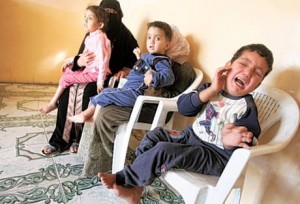By Wayne White
An excellent October 18 article, “The Myth of ‘Surgical Strikes’ on Iran“, by David Isenberg highlighted many of the conclusions of a sobering study by industrialist Khosrow Semnani on the potentially steep human cost of even a relatively selective attack against Iran’s diverse nuclear infrastructure. Semnani maintains that if the most important facilities [...]]]>By Wayne White
 An excellent October 18 article, “The Myth of ‘Surgical Strikes’ on Iran“, by David Isenberg highlighted many of the conclusions of a sobering study by industrialist Khosrow Semnani on the potentially steep human cost of even a relatively selective attack against Iran’s diverse nuclear infrastructure. Semnani maintains that if the most important facilities are hit during work shifts, on site casualties could be as high as 10,000. Additionally, since a few of the most important Iranian nuclear installations are located near population centers, toxic nuclear materials unleashed by the attacks could possibly inflict an even higher number of casualties on civilians. Yet, Semnani focused most of his attention on the the casualties stemming from attacks focused on just one critical slice of the nuclear sector, with less detailed references to other targets (which he notes could involve a grand total of “400″) that might be struck in an especially robust air campaign against Iran. Indeed, if the US in particular decided to carry out such attacks, some detail on the potential — in fact likely — impact far beyond Iran’s most high-profile nuclear facilities and their immediate surroundings needs to be added to this picture to gain a full appreciation of the extent of potential Iranian casualties.
An excellent October 18 article, “The Myth of ‘Surgical Strikes’ on Iran“, by David Isenberg highlighted many of the conclusions of a sobering study by industrialist Khosrow Semnani on the potentially steep human cost of even a relatively selective attack against Iran’s diverse nuclear infrastructure. Semnani maintains that if the most important facilities are hit during work shifts, on site casualties could be as high as 10,000. Additionally, since a few of the most important Iranian nuclear installations are located near population centers, toxic nuclear materials unleashed by the attacks could possibly inflict an even higher number of casualties on civilians. Yet, Semnani focused most of his attention on the the casualties stemming from attacks focused on just one critical slice of the nuclear sector, with less detailed references to other targets (which he notes could involve a grand total of “400″) that might be struck in an especially robust air campaign against Iran. Indeed, if the US in particular decided to carry out such attacks, some detail on the potential — in fact likely — impact far beyond Iran’s most high-profile nuclear facilities and their immediate surroundings needs to be added to this picture to gain a full appreciation of the extent of potential Iranian casualties.Yet, as opposed to the relatively limited scope of any Israeli attack dictated by the extreme range involved and the smaller aerial strike package that could be deployed (in terms of extending casualties beyond those outlined in the article and Semnani’s study, both nuclear and civilian), many expect that any US attack on Iran’s nuclear capabilities would be far more comprehensive. Specifically, the US would be able to muster a much larger force of aircraft (and cruise missiles) with which to operate, and at far closer range. In order to clear paths to the targets cited, I am among those observers who anticipate in such a scenario waves of parallel US strikes against Iranian military communications, land-based anti-ship missile sites, any Iranian naval forces that could pose a potential threat to US warships operating offshore (as well as the Strait of Hormuz more generally), Iranian air force aircraft and bases, as well as Iranian anti-aircraft defenses. Finally, there might also be an attempt to take out as much of Iran’s ballistic missile testing, manufacturing, storage, and basing assets as possible. After all, Iran’s ambitious missile program relates directly to Iran’s ability to retaliate and might be associated with any eventual Iranian intent to weaponize and deliver nuclear weapons.
In other words, not only could a US assault (much as outlined in 2006 by the US military in its briefings of the Bush Administration, including potentially several thousand missions by combat aircraft) extend far beyond anything any reasonable individual could possibly regard as ”surgical,” the overall attack probably would more closely resemble a flat-out war. And, naturally, in the context of such a considerably more dire scenario, those attempting to estimate potential casualties (nuclear industry workers, civilians, as well as Iranian military personnel) would be advised to hike them up quite a bit higher.
- Wayne White is a Policy Expert with Washington’s Middle East Policy Council. He was formerly the Deputy Director of the State Department’s Bureau of Intelligence and Research’s Office of Analysis for the Near East and South Asia (INR/NESA) and senior regional analyst. Find his author archive here.
After being asked to give his take on a recent report about the human costs of attacking Iran’s nuclear facilities, a prominent commentator on US-Iran relations said it was an “inexact science” and declined further comment even though he called the project a worthy endeavor. While the idea that inflicting [...]]]>
 After being asked to give his take on a recent report about the human costs of attacking Iran’s nuclear facilities, a prominent commentator on US-Iran relations said it was an “inexact science” and declined further comment even though he called the project a worthy endeavor. While the idea that inflicting physical damage on a nuclear site would cause serious harm to surrounding biological entities seems indisputable, at least the after-effects of the 2003 US-led invasion of Iraq tragically continues to serve as a case study for the impact a prolonged war with Iran — required if the goal is to set back Iran’s nuclear program by more than a few years — would have on the human population. According to a new study first reported on by the Independent, there has been a significant rise in Iraqi birth defects in cities that were hard-hit by US-led forces during the war:
After being asked to give his take on a recent report about the human costs of attacking Iran’s nuclear facilities, a prominent commentator on US-Iran relations said it was an “inexact science” and declined further comment even though he called the project a worthy endeavor. While the idea that inflicting physical damage on a nuclear site would cause serious harm to surrounding biological entities seems indisputable, at least the after-effects of the 2003 US-led invasion of Iraq tragically continues to serve as a case study for the impact a prolonged war with Iran — required if the goal is to set back Iran’s nuclear program by more than a few years — would have on the human population. According to a new study first reported on by the Independent, there has been a significant rise in Iraqi birth defects in cities that were hard-hit by US-led forces during the war:
The latest study found that in Fallujah, more than half of all babies surveyed were born with a birth defect between 2007 and 2010. Before the siege, this figure was more like one in 10. Prior to the turn of the millennium, fewer than 2 per cent of babies were born with a defect. More than 45 per cent of all pregnancies surveyed ended in miscarriage in the two years after 2004, up from only 10 per cent before the bombing. Between 2007 and 2010, one in six of all pregnancies ended in miscarriage.
The new research, which looked at the health histories of 56 families in Fallujah, also examined births in Basra, in southern Iraq, attacked by British forces in 2003. Researchers found more than 20 babies out of 1,000 were born with defects in Al Basrah Maternity Hospital in 2003, a number that is 17 times higher than recorded a decade previously. In the past seven years, the number of malformed babies born increased by more than 60 per cent; 37 out of every 1,000 are now born with defects.
The US response:
A US Defense Department spokesperson said: “We are not aware of any official reports indicating an increase in birth defects in Al Basrah or Fallujah that may be related to exposure to the metals contained in munitions used by the US or coalition partners. We always take very seriously public health concerns about any population now living in a combat theatre. Unexploded ordnance, including improvised explosive devises, are a recognised hazard.”
But a series of studies have suggested links between the bombardments and a rise in Iraqi birth defects:
]]>Their preliminary findings, in 2010, prompted a World Health Organisation inquiry into the prevalence of birth defects in the area. The WHO’s report, out next month, is widely expected to show an increase in birth defects after the conflict. It has looked at nine “high-risk” areas in Iraq, including Fallujah and Basra. Where high prevalence is found, the WHO is expected to call for additional studies to pinpoint precise causes.